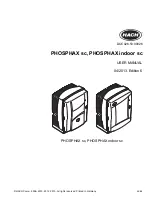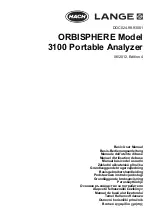
APOLLO 4000
OXYGEN DETECTION
World Precision instruments
d-9
autoclaved seperately
from the probe should the
user desire to do this and
then place the sterilized
membrane sleeve onto
the probe.
Changing the
membrane
sleeve
All membrane sleeves
replacing will eventually
have to be done by the
user. the procedure for
doing is simple and straightforward.
1.
unscrew the locking cap from the handle.
2.
Hold the stainless steel sleeve and remove it with the locking cap from the
internal electrode, being careful not to bend the electrode assembly when
doing so.
3.
rinse the internal electrode with distilled water (particularly the tip) and
let it soak for at least 5 minutes. Be careful not to let water get into the
handle. the current on the APollo 4000 should go offscale when the
electrode is being rinsed.
4.
Gently dry the electrode with a soft tissue (Kimwipes). Be sure to dry
thoroughly the flat surface at the tip of the electrode. After drying the
current should stabilize fairly quickly to a low value (
e.g.
, 0 - 20 pA). if this
occurs, then the electrode is in good working order.
5.
if the electrode is not clean, repeat steps 3 and 4.
6.
remove the locking cap from the old used sleeve, and gently slide it onto
the new replacement sleeve.
7.
dip the internal electrode -2 cm into the electrolyte , the current should
go offscale during this. using the microFil™ non-metallic syringe needle
and ml plastic syringe, supplied, inject approximately 00 ul of
electrolyte directly into the new sleeve. the microFil supplied should be
Fig. D5
— Principal
components
of ISO-OXY-2
electrode.
1
2
3
4
Summary of Contents for APOLLO 4000
Page 2: ......
Page 4: ......
Page 10: ...APOLLO 4000 INTRODUCTION WORLD PRECISION INSTRUMENTS A 6...
Page 48: ...APOLLO 4000 NITRIC OXIDE DETECTION WORLD PRECISION INSTRUMENTS C 24...
Page 70: ...APOLLO 4000 TROUBLESHOOTING WORLD PRECISION INSTRUMENTS F 2...
Page 72: ......
Page 74: ......
















































